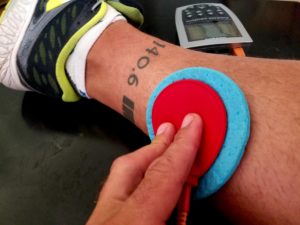Microcurrent Therapy
The MENS Microcurrents The microcurrent stimulation is being increasingly used. In USA and other countries such as Japan, Canada etc., the MCR also called MENS is considered one of the more used current in physiotherapy and clinical applications (differing from TENS which, as well known, is particularly indicated for pain relief).
A number of studies have demonstrated excellent results in therapy and various protocols and parameters have been defined (protocols and parameters that we have included in our stimulators). For particular pathologies and situations, we suggest referring to your physician. Compared with conventional electrostimulation therapy, which utilizes electrical current at the milliampere (mA) level, microcurrent utilizes a less intense microampere current for therapy (microampere μA). This slight electrical current is below the human threshold of perception and it is not therefore felt by the patient.
MENS therapy offers patient the following advantages:
-Safe
-Comfort
-Acute and chronic pain relief
-Accelerated regeneration of damaged tissues and rapid healing of wound, cicatrix, and bone fractures.
-Collagen fiber production, promoting elasticity of the skin
-Total absence of side effects and complications.
Brief history of MENS electrostimulation therapy The neuromuscular electrostimulation therapy with microcurrent (MENS) was developed approximately 20 years ago. Lynn Wallace treated more than 600 patients with MENS and examined its clinical effects on pain caused by various disorders of the feet, lower limbs, femur, lumbar area, shoulders, elbows, and neck, and found a remarkable sedative effect. According to Wallace, the initial treatment of 15-20 minutes provided some element of pain relief in more than 95% of patients. The extent of pain reduction was an average 55% after the first treatment, 61% after the second treatment, and 77% after the third treatment. The pain was completely disappeared in 82% of patients after less than 10 treatments (four treatments on average).
Many studies are possible with MENS as its stimulation is not discernible by the patient. Lerner and Kirsch conducted experiments on 40 patients with chronic low back pain in which patients were randomly allocated to a MENS treatment group and a placebo group that was hooked up to dummy MENS units that provided no electrostimulation. Stimulation was conducted three times a week for eight weeks. Results showed pain reduction of an average 75% in the MENS treatment group and only 6% in the placebo group. A number of studies have also found that MENS promotes the healing of wounds and ulcers. Gault and Gatens reported a positive effect of MENS in 106 patients with ischemia skin ulcers. In their study, the group treated with MENS using an intensity of 200 μA – 800 μA current recovered approximately twice as fast as the non-treated control group. It has also been reported by a number of clinicians that the healing of bone fractures is greatly facilitated by low-level electrical current. The above-mentioned results demonstrate that MENS is markedly effective in treating acute and chronic pain, promotes regeneration of damaged tissues, and heals wounds, cicatrix, and bone fractures. (Gault WR, Gatens PF Jr : Use of low intensity direct current in management of ischemic skin ulcers. Phys Ther 56~265, 1976.)
Functional mechanism of the MENS currents, “Injury current” and the MENS functions The functional mechanism of MENS is complicated and has to be fully analyzed yet. Although a variety of conflicting theories exists, sufficient research findings have been accumulated that the following conclusion seem justified.
It has been clear for over a century that an electrical potential of about -5OmV is present in the cell membrane. This potential is known as the resting membrane potential. The outer surface carries a positive charge, while the inner surface has a negative charge [Img.3]. When a cell is damaged, the potential of the injured part becomes negative, and the electric current flows from the normal area to the injured area This phenomenon was accurately measured by Matteucci (1938) and Bois-Reymond (1843), this current is commonly known as “injury current”.
Injury current is generated not only when individual cells are injured but also when the tissue is damaged. The intensity of the injury current ranges from 10 μA to 30 μA, as demonstrated by experiments. In other words, injury current is a microcurrent. Injury current is considered to promote the recovery of damaged cells and tissues in the living body. Stimulation by this current is thought to generate ATP and to synthesize protein for the restoration of damaged tissue. Therefore, it can be affirmed that artificially generated microcurrent would complement and further promote the natural functions of the injury current.
Phases and duration of Mens therapy is ordinarily executed in the following two phases. Phase 1 is mainly intended to reduce pain, while phase 2 is designed to solve the trauma and to repair the damaged tissue.
Whereas phase 1 offers rapid pain relief, phase 2 promotes ATP production and protein synthesis to accelerate tissue recovery, providing basic healing.
These two phases are executed in succession with phase 2 following immediately after phase 1. Treatment duration ranges from 15 to 30 minutes in phase 1 and from 5 to 10 minutes in phase 2 (5 minutes standard).
Treatment sessions vary according to the condition being treated. Generally, once a day or once every other day is sufficient. To achieve satisfactory results, the therapy period can vary from 10 to 45 days.
Five to ten follow-up sessions are recommended after satisfactory results have been achieved.